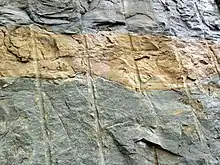Seismite
Seismites are sedimentary beds and structures deformed by seismic shaking. The German paleontologist Adolf Seilacher first used the term in 1969[1] to describe earthquake-deformed layers. Today, the term is applied to both sedimentary layers and soft sediment deformation structures formed by shaking. This subtle change in usage accommodates structures that may not remain within a layer (i.e., clastic dikes or sand volcanos).[2][3]


| Part of a series on |
| Earthquakes |
|---|
|
Caution is urged when applying the term to features observed in the field, as similar-looking features may be products of either seismic or non-seismic perturbation.[4][5][6] Several informal classification systems exist to help geologists distinguish seismites from other soft-sediment deformation features,[7][8][9][10][11][12][13][14][15][16] though a formal, standardized system has not been developed.
Geologists use seismites, in combination with other evidence, to better understand the earthquake history of an area. If age and distribution of seismically-generated features can be determined, then recurrence interval and seismic hazard risk can be assessed.[17][18][19][20]
References
- Seilacher, A., 1969, Fault-graded beds interpreted as seismites, Sedimentology, 13, p. 15-159
- Seilacher, A., 1984, Sedimentary structures tentatively attributed to seismic events, Marine Geology, 55, p. 1-12
- Van Loon, A.J., 2014, The life cycle of seismite research, Geologos v. 20, p. 61-66
- Owen, G.; Moretti, M., 2011, Identifying triggers for liquefaction-induced soft-sediment deformation structures in the Acequion River valley, Central Precordillera, Argentina, Geology, v. 235, p. 141-147
- Moretti, M; Van Loon, A.J, 2014, Restrictions to application of 'diagnostic' criteria for recognizing ancient seismites, Journal of Palaeogeography, v. 3, p. 162-173
- Sims, J.D., 1975, Determining earthquake recurrence intervals from deformational structures in young lacustrine sediments, Tectonophysics, v. 29, p. 141-152
- Seilacher, A., 1969, Fault-graded beds interpreted as seismites, Sedimentology, 13, p. 15-159
- Mills, P.C., 1983, Genesis and diagnostic value of soft-sediment deformation structures – a review, Sedimentary Geology, 35, p. 83-104
- Groshong, R.H., 1988, Low-temperature deformation mechanism and their interpretation, GSA Bulletin, 100, p. 1329-1360
- Allen, C.R., 1975, Geological criteria for evaluating seismicity, GSA Bulletin, 86, p. 1041-1057
- Guiraud and Plaziet, 1993
- Obermeier, S.F., 1996b, Use of liquefaction-induced features for paleoseismic analysis – an overview of how seismic liquefaction features can be distinguished from other features and how their regional distribution and properties of source sediment can be used to infer the location and strength of Holocene paleo-earthquakes, Engineering Geology, 44, p. 1-46
- Greb, S.F.; Ettensohn, F.R.; Obermeier, S.F., 2002, Developing a classification scheme for seismites, GSA North-central & Southeastern Section Annual Meeting Abstracts with Programs
- Wheeler, R.L., 2002, Distinguishing seismic from nonseismic soft-sediment structures: Criteria from seismic-hazard analysis, in Ettensohn, F.R.; Rast, N.; Brett, C.E. (editors), Ancient Seismites, GSA Special Paper, 359, p. 1-11
- Obermeier, S.F.; Olson, S.M.; Green, R.A., 2005, Field occurrences of liquefaction-induced features: a primer for engineering geologic analysis of paleoseismic shaking, Engineering Geology, 76, p. 209-234
- Montenat, C.; Barrier, P.; d'Estevou, P.O.; Hibsch, C., 2007, Seismites: An attempt at critical analysis and classification, Sedimentary Geology, 196, p. 5-30
- Jewell and Ettensohn, 2004, An ancient seismite response to Taconian far-field forces: the Cane Run Bed, Upper Ordovician (Trenton) Lexington Limestone, Central Kentucky (USA),
- Bachmann, G.H., Aref, M.A.M., 2005, A seismite in Triassic gypsum deposits (Grabfeld Formation, Ladinian), southwestern Germany, Sedimentary Geology, 180, p. 75–89, doi = 10.1016/j.sedgeo.2005.04.006
- Jewell, H.E., Ettensohn, F.R., 2004, An ancient seismite response to Taconian far-field forces: the Cane Run Bed, Upper Ordovician (Trenton) Lexington Limestone, Central Kentucky (USA), Journal of Geodynamics, 37, p. 487–511, doi = 10.1016/j.jog.2004.02.017
- Merriam, D.F., Neuhauser, K.R., 2009, Seismite Indicates Pleistocene Earthquake Activity in Ellis County, Kansas, Transactions of the Kansas Academy of Science, 112, p. 109–112, doi = 10.1660/062.112.0214